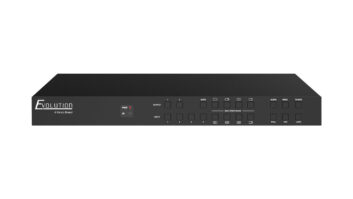The Consumer Technology Association (CTA) is bullish about 4K Ultra HD and emerging new video technologies.
Communications director Jeff Joseph dropped some statistics on a small gathering of press members at this month’s CEDIA 2916 in Dallas, and the signs of a full-blown 4K era have finally arrived.
New display technologies provide a more immersive and realistic experience, Joseph said.
“I believe that 4K is our destiny – standing as the exciting next development in the consumer home entertainment experience. Seeing is believing – 8 million-plus pixels – four times the resolution of FullHD, powerful up-scaling, lifelike colors, more detail and more. The time is right.”
CTA research shows video is still king based on consumer surveying. Sixty-two percent of those consumers surveyed plan to purchase some form of Ultra HD content viewing device in next 12 months, and 29 percent plan to purchase a TV in next 12 months. This is second only to smartphones at 33 percent, while 77 percent of those surveyed would choose to purchase a TV to view content if they only had one screen.
Screen size (80 percent) and picture quality (62 percent) drive preference for TV, indicating strong promise for 4K.
“Diffusing video consumption behavior is particularly relevant as we look to the increasing development and distribution of native 4K content,” Joseph said. Some 50 to 60 percent of homes have Internet-enabled TV, and 46 percent view content through paid streaming services. Demographically, 62 percent of millennials receive content via a paid streaming service vs. 38 percent of those 35 and older.
But the bottom line is, sales confirm 4K UHD TV is a reality. Fifteen million units will sell this year, marking a 105 percent increase over 2015’s 7 million units. We are inching up to 4K UHD TVs composing nearly 50 percent of TV sales. Four in 10 sets shipping this year will be 4K UHD, and virtually all TVs over 50 inches are now 4K UHD.
Shipment revenues of 4K Ultra HD displays are expected to top $12 billion in 2016 – a 69 percent increase over 2015. Ultra HD TVs are now selling at a faster pace than HD sets sold during the digital transition in the same period with Ultra HD units at 15 million and HDTV units at 2.9 million.
Prices are dropping fast, bringing UHD sets into the consumer purchasing sweet spot. Average wholesale unit price declined from $1,048 in 2015 to an estimated $861 in 2016.
CTA is also excited about all the next generation technologies — HDR, wide color gamut, higher frame rates — though most of CTA’s work to date has been centered on HDR. CTA estimates roughly 10 percent of 4K sets shipped this year will be HDR-compatible, rising to 23 percent in 2017.
As for content, the first Ultra HD Blu-ray Disc players are now on the market with a growing selection of top movies available including box office hits such as “The Revenant” and “The Martian.” CTA forecasts 2016 4K UHD Blu-ray sales of 700,000 units sold and $63 million in revenue, with many more UHD Blu-ray Disc player announcements expected at CES 2017.
Netflix has announced plans to stream 600 hours of 4K content by end of 2016 and will stream HDR by end of this year. Amazon has been streaming select TV shows, movies and specials in 4K and NBC, DirecTV and Dish all showed the Summer Olympics in 4K. Sony and Intel just announced a 4K streaming service, but only for Sony TVs.
What Defines An HDR TV?
The Consumer Technology Association’s (CTA) definition for high dynamic range compatible video displays is designed to assist retailers and consumers in identifying display products that incorporate the interface and processing technology needed to display the new content properly.
HDR greatly improves the contrast ratio of video content on HDR-enabled TVs, delivering much brighter highlights and much deeper blacks without washing out details in the bright and dark. It also delivers a far wider color gamut than conventional displays.
CTA’s Video Division Board approved the following definition: A TV, monitor or project may be referred to as a HDR Compatible Display if it meets the following minimum attributes:
• Includes at least one interface that supports HDR signaling as defined in 861-F, as extended by 861.3
• Receives and processes static HDR metadata compliant with 861.3 for uncompressed video.
• Receives and processes HDR10 Media Profile from IP, HDMI or other video delivery sources. Additionally, other media profiles may be supported.
• Applies an appropriate Electro-Optical Transfer Function, before rendering the image.
These characteristics for HDR interoperability were developed in collaboration between CTA and its display manufacturer members with leading content providers and distributors. CTA has also implemented a variety of promotional efforts to help educate consumers and retailers about the new display technology.













